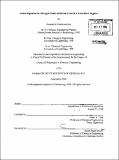Nanocomposites for nitrogen oxide emissions control in lean-burn engines
Author(s)
Pitukmanorom, Pemakorn, 1976-
DownloadFull printable version (7.253Mb)
Other Contributors
Massachusetts Institute of Technology. Dept. of Chemical Engineering.
Advisor
Jackie Y. Ying.
Terms of use
Metadata
Show full item recordAbstract
(cont.) reducing agent than propane in the SCR of NO. Pt-Rh/CuO/A1₂O₃ nanocomposites capable of adsorbing SO₂ in oxygen-rich environment as metal sulfates and releasing SO₂ in reducing atmosphere were synthesized with sequential precipitation technique. These CuO-based sorbents possessed excellent SO₂ adsorption capacity and superior regenerability by CO compared to those produced by the impregnation method due to higher surface area and dispersion of Cu species. A gram of sorbent with 30 wt% Cu could adsorb over 50 mg of SO2 before SO₂ breakthrough was observed. The rate of SO₂ desorption from the CuO/A1₂O₃ sorbents could be enhanced through the incorporation of noble metals. With the use of 0.1 wt% Pt, the CuO/A1₂O₃ sorbent with 30 wt% Cu could be regenerated twice as quickly. Also, on average only 8 ppm of SO₂ were detected downstream of this sorbent over each adsorption cycle at 400⁰C. The excellent sorbent regeneration was attributed to better CO adsorption and lower sulfate decomposition temperature as a result of Pt addition. The nature of sulfur deactivation of these sorbents was highly dependent on the composition of noble metals used. By employing both Rh and Pt, sorbent regeneration rate and stability could be optimized. Rh/CuO-MgO/A1₂O₃ nanocomposites capable of adsorbing NOx and SO₂ in oxygen-rich environment and releasing N₂ and SO₂ in reducing atmosphere were successfully prepared by sequential precipitation ... Over the past few years, increase in environmental concern has led to a demand for more effective pollution control strategies that would satisfy the new EPA standards regarding automotive emissions of nitrogen oxides (NOx). In particular, the removal of NOx from lean-burn and diesel engines operating under an oxygen-rich atmosphere presents a significant challenge as conventional three-way catalysts are ineffective in this environment. Moreover, the presence of water vapor and sulfur oxides (SOx) in the exhaust stream both inhibits catalyst activity and results in long-term catalyst instability. Thus, it is necessary to develop novel technologies for the removal of NOx from the exhaust of lean-bum engines. This thesis examined three metal oxide nanocomposite systems to serve as (i) catalysts for the selective catalytic reduction (SCR) of NOx by propene, (ii) sorbents for SO₂ storage, and (iii) catalysts for NOx storage-reduction (NSR). In₂O₃-Ga₂O₃/A1₂O₃ nanocomposite catalysts have been synthesized using the sequential precipitation technique. These alumina-based catalysts exhibited superior NO reduction activity to those produced by the impregnation and sol-gel methods due to their higher surface area and dispersion of active components. In fact, an excellent N2 yield of 80% was achieved at 450⁰C over the In₂O₃-Ga₂O₃/A1₂O₃ nanocomposite with 2 wt% In and 8 wt% Ga. The high catalytic activity was attributed to better propene activation by In and improved NOx adsorption on the high surface area Ga₂O₃/A1₂O₃. The In₂O₃-Ga₂O₃/A1₂O₃ nanocomposite remained active even in the presence of SO2. The NO reduction activity of this catalyst system depended on the hydrocarbons that were used as the reducing agents. Propene was found to be a more effective
Description
Thesis (Ph. D.)--Massachusetts Institute of Technology, Dept. of Chemical Engineering, 2004. Includes bibliographical references.
Date issued
2004Department
Massachusetts Institute of Technology. Department of Chemical EngineeringPublisher
Massachusetts Institute of Technology
Keywords
Chemical Engineering.